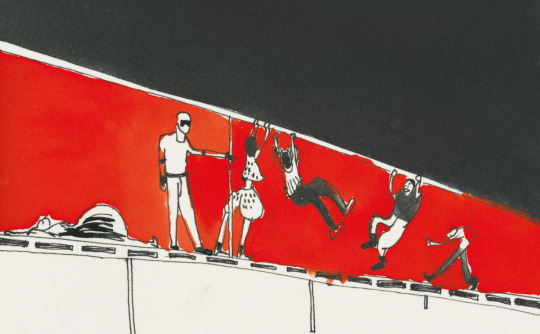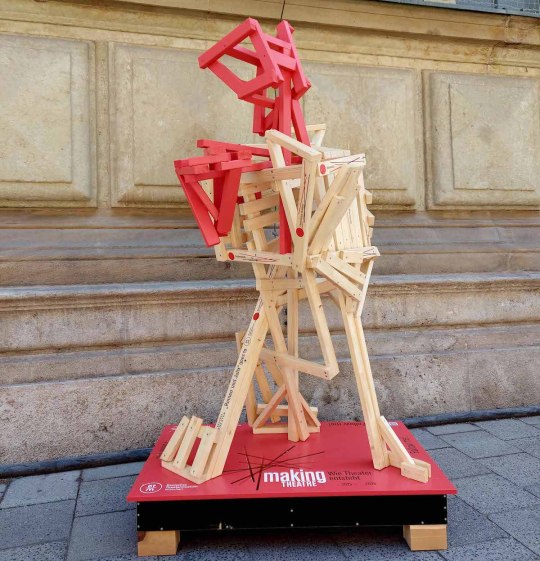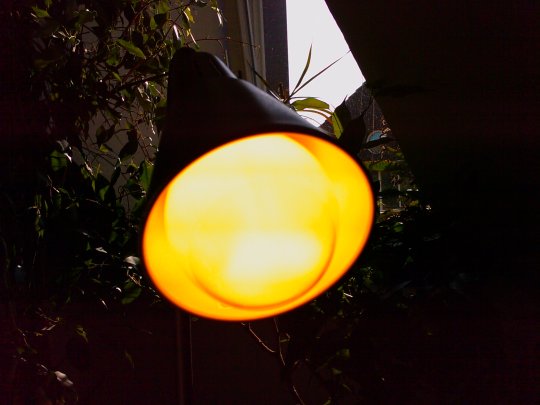🇬🇧 Notes on things I’ve read, random thoughts I post here in lieu of Twitter, reposts of things I like or that interest me, and English translations of my writings elsewhere. 🇩🇪 Zettelkasten von @martinjost. Versuch über die allmähliche Verfertigung der Gedanken beim Publishen.
Don't wanna be here? Send us removal request.
Text
Wie ich versuche, einen Bogen um KI-Scheiß zu machen, während Dienstleisterinnen versuchen, mir KI-Features als Mehrwert zu verkaufen ...
11 notes
·
View notes
Text

Es ist mein 2. Jahrestag auf Tumblr 🥳
0 notes
Text
🎭 making THEATRE – German Theatre Museum Munich
An exhibition reveals how a stage production takes shape
That’s Curtains For The Drop
How theatre is created is explored in the German Theatre Museum in Munich. For an entire year, the curators accompanied artists and departments of the Residenztheater throughout the development of a Romeo and Juliet production. And they found a way to connect the ephemeral nature of the theatrical experience with the permanence of a museum exhibition.
By Martin Jost · First published on nachtkritik.de · Translated with the aid of a. i.

© Karen Stuke
Of Elsa-Sophie Jach’s Romeo and Juliet at the Munich Residenztheater, this critic wrote that a few teeth were knocked out during the Capulet–Montague feud. But the sound of teeth rattling on the pavement was merely a sound effect. At least, that's what the reviewer might have thought—until learning otherwise in the current exhibition at the German Theatre Museum. “making THEATRE – How Theatre Is Created” features, among other things, the original Tic Tacs the actors spat out as faux teeth on stage.
The exhibition traces the creation of a stage production from first plans to opening night. As a concrete example, curator Maren Richter chose Romeo and Juliet, which was being developed simultaneously just a short walk away at the Residenztheater.
The true purpose in life of a mint drop lies in its dissolution. That it ends up in a museum as a half-dissolved artifact is symbolic of the exhibition’s central paradox: the ephemeral art of theatre is translated into a display object in a museum—an institution that prevents artifacts from vanishing. From day one, Maren Richter and her team accompanied the production process at the Residenztheater, gradually building their exhibition around it.
Long-Exposure Technical Wonder
Another powerful metaphor for the paradox between ephemerality and permanence is Karen Stuke’s pinhole camera photograph of the final rehearsal of Romeo and Juliet. The three-hour-long exposure reveals a glowing, translucent cylinder blurred by motion. Anyone who saw the production will immediately recognize Marlene Lockemann’s scenic marvel: a rotating platform of spiral-balcony-lattice-staircase-wall that filled the otherwise empty stage of the Residenztheater.
In the upper part of the photograph, a ruffled collar suggests the presence of a character, along with an S-shaped glowing trace indicating someone who remained in one spot longer. Not particularly flattering for the actors, who are nearly indistinguishable in this camera obscura snapshot—but the work of the set designer and lighting team is unmistakable.

🎨 Live Illustration by Lisa Frühbeis of Elsa-Sophie Jach's production of “Romeo and Juliet” at the Residenztheater Munich © Lisa Frühbeis
Giving Equal Weight to the Work Behind the Scenes
Making THEATRE presents the work of the various departments and crafts in such a way that visitors gain a realistic impression of the largely invisible contributions made to a production. At the exhibition's opening, Residenztheater artistic director Andreas Beck described the collaboration with the museum as follows: “This exhibition is also a form of advertising for careers in the theatre.”
Grown Through Trial and Error
The exhibition layout spans three floors, guiding visitors through the year-long process—from creating the season schedule to the premiere of Romeo and Juliet. On display is a varied mix of sketches, remnants, documentary materials, and meta-texts.
Among the designs, we see set designer Marlene Lockemann’s sketchbook, different stage models, and technical drafts by constructor Paul Demmelhuber for the intricate structure. Tattered prompt books and handwritten tech notes reveal how theatre grows through trial and error.
The peppermint Tic Tac teeth are a byproduct of rehearsals, just like the meticulously handcrafted wig once intended for Lea Ruckpaul’s Juliet. That wig is exhibited now because it was cut from the production during rehearsals and no longer needed on stage.
Scent Samples and Discourse Artifacts
Some of the documentary materials were created by the exhibition team themselves using a method called “live curation.” Johanna Seggelke’s immersive film captures what unfolds backstage during a three-hour performance of Romeo and Juliet—shown from multiple camera perspectives, without pans or cuts.
Lisa Frühbeis illustrated a reportage-style comic during rehearsals. Additional videos and interviews document the work in the Residenztheater’s workshops. Visitors can even experience the smell of theatre: scent samples from various departments allow guests to literally sniff backstage air. (A word of caution—it’s best not to stick your nose too deep into the jar from the paint studio.)

Theatrical creature assembled from everyday workshop materials. Photo: Babette Angelaeas, German Theatre Museum
Explanatory texts skillfully situate these objects within a broader understanding of theatre work and open up insightful thematic excursions. One timeline traces how digital technology has gradually entered stagecraft over recent decades.
Since visitors now appreciate how complex a theatre production truly is, the exhibition doesn’t shy away from addressing sensitive industry issues: hierarchies, compensation structures, and abuses of power are all explored. Diagrams offer a clear visual of how wages have developed across theatre professions.
The exhibition also shares insights into the lasting effects of inclusion in theatre. A case in point: Munich’s Kammerspiele, whose ensemble members and artistic director Barbara Mundel speak in interviews. Nearby, you’ll find a facsimile of the HORA Manifesto and a summary of Rouven Costanza’s research.
Making-of for the Production
Ironically, the most valuable exhibit is easy to miss at first glance. Right at the entrance sits a First Folio from 1623—a well-preserved first edition of Shakespeare’s collected works. This treasure from the University Library of Cologne would be worth the visit on its own. Its connection to the exhibition is subtle but significant, highlighting the enduring legacy of Shakespeare’s texts.

For all the complexity of its subject matter and the frequent digressions into historical and thematic side topics, the exhibition leaves a clear and illuminating overall impression. That’s thanks in no small part to the top-notch curatorial texts and the design by Sigi Colpe.
First Folio, Mr. William Shakespeares Comedies, Histories & Tragedies. London, 1623 (Original). Verlegt von John Heminges und Henry Condell
Folio geöffnet, Doppelseite To the Reader (Ben Jonson) und Kupferstich-Portrait (Martin Droeshout). Foto © Simon Epp, Universitäts- und Stadtbibliothek Köln.
The original First Folio will only be on display in Munich for the first three months of the exhibition. After September, 2025, it will be replaced by a faksimile.
For anyone who remembers the DVD era, it feels like a making-of bonus feature accompanying the “main film” that is Romeo and Juliet. As a follow-up to the stage production, making THEATRE is the perfect companion—but even on its own, the exhibition is a rich and rewarding experience.
▶️ making THEATRE – How Theatre Is Created A special exhibition by the German Theatre Museum Curator: Maren Richter Cinematography, editing & live curation: Johanna Seggelke Live illustration: Lisa Frühbeis Exhibition design: Studio Colpe, Hamburg (Sigi Colpe, Kilian Landwehr) Graphic design: Judith Löhrs Exhibition dates: June 25, 2025 – April 12, 2026 deutschestheatermuseum.de/en/
Read More:
#theater#review#criticism#nachtkritik#German theater#Shakespeare#Romeo and Juliet#exhibition#munich#theater museum#01319
19 notes
·
View notes
Text
„Aktuell befinden wir uns in einem politischen Backlash: Viele Menschen ignorieren die Umstände oder glauben, das wird schon wieder. Oder sie sind weniger besorgt, weil sie glauben, selbst nicht betroffen zu sein.“
—Hadija Haruna-Oelker
https://www.gasteig.de/magazin/jeder-mensch-kann-heldenhaft-sein-gespraech-mit-hadija-haruna-oelker/
1 note
·
View note
Text

Heir to Austro-Hungarian Empire, Franz Ferdinand and his spouse Sophie dressed as a Mummy and a Sphinx respectively during their trip to Egypt in 1894.
2K notes
·
View notes
Text

[K.I. so:] Auf dem Bild ist eine Lampe zu sehen, die ein warmes, gelbes Licht ausstrahlt. Sie ist von Pflanzen umgeben, was eine gemütliche Atmosphäre schafft. Im Hintergrund befindet sich ein Fenster mit Tageslicht. Das Bild könnte für Geborgenheit und Wärme stehen, da das sanfte Licht eine einladende Atmosphäre schafft. Die Pflanzen symbolisieren Wachstum und Naturverbundenheit, während das Fenster im Hintergrund Offenheit und neue Perspektiven darstellen kann. Die warme Beleuchtung und die natürliche Elemente schaffen eine stimmungsvolle Komposition. Die Bildgestaltung wirkt harmonisch, und das Zusammenspiel von Licht und Schatten verleiht ihm Tiefe. Ein leichtes Spiel mit dem Fokus könnte bestimmte Details noch mehr hervorheben.
1 note
·
View note
Text

An ancient Greek kylix showing a baby sitting in his pottychair and calling to his mother. ca. 480 BCE, the Royal Museums of Art and History, Brussels. And a 6th Century BCE potty found in the Athenian Agora. Agora Museum, Athens
More: https://thetravelbible.com/top-artifacts-from-ancient-greece/
2K notes
·
View notes
Text
Bitte erpresst mich nicht mit meinen leeren Versprechen.
1 note
·
View note
Text

Trekkie-Imperativ: Handle stets so, dass die absehbaren Folgen deines Handelns im besten Fall auf eine Zukunft einzahlen, in der wir alle gerne leben möchten und so, dass die unabsehbaren Folgen dieser Zukunft wenigstens nicht im Wege stehen. 🖖🏻
Trekkie Imperative: Always act in such a way that the foreseeable consequences of your actions contribute to a future in which we would all like to live—and that the unforeseeable consequences at least do not stand in the way of that future.
1 note
·
View note
Text
„Ich möchte gern 1 kunst machen die die tiefsten + wichtigsten dinge berührt + 1000 jahre geht: sie soll nicht so ernst sein.“
—Bertolt Brecht
Zitiert nach: Müller-Schöll, Nikolaus. »Nicht ganz ernst« (Rez. Bertolt Brecht: Notizbücher 21–23. 1927–1929. Suhrkamp Verlag). Theater heute, April 2024, S. 70.
1 note
·
View note




